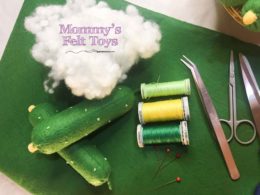Table of Contents
Still don’t know how to sew felt? Do not despair because most people who are just starting to sew felt have doubts and fears. The good news is that making the four basic stitches for felt doesn’t involve much mystery. You can learn felt sewing techniques in minutes and practice until you’re an expert.
See Also: Felt Crafts for Beginners – The Complete Guide
The tip for felt craft beginners is to train on smaller pieces of felt first. Then, you will have enough skill to produce more significant parts in a short practice time, and you will usually only need a felt mold to do projects.
How to Sew Felt by Hand?
Although whimsical, sewing felt by hand can be done by anyone. You only need goodwill and perseverance to learn how to sew felt. Check out some little secrets for a perfect felt stitch!
It is essential to note the space between one point and another. In this way, you will make things that attract people’s attention look good and beautiful. But you have to be a little careful while choosing the needle.
To sew felt, choose a simple needle of the thickness and size that suits you best. Fine-tipped needles pierce the felt better and do not show the hole marks much.
Opt for simple yarns of the same color as the felt for more delicate results. However, if you want to highlight details such as eyes and mouth in your felting craft project, it is better to use a different yarn color. Thus, while processing the felt, the decorative piece will also stand out and look more beautiful.
Check out the “What is the best yarn for felting” post and see more tips.
Do not forget that the yarn of the same color as the felt gives more delicate and beautiful results.
Want to learn how to sew felt? Take a step-by-step look at the most used points: buttonhole stitch, basting stitch, back, and blanket stitch!
1- Buttonhole Stitch
Buttonhole stitching, also known as button stitching, is used in embroidery and embroidered lace. Felt is most common in crafts because it is simple and, at the same time, gives a delicate finish and is durable.
It looks much like the blanket stitch. However, it is called a buttonhole stitch when the stitches are tightly packed together. When more evenly spaced, it is called a blanket stitch or blanket-edge stitch.
The needle is placed into the upper half of the loop and then left to hang around the circle’s lower boundary. Next, the needle is pulled out over the working thread to create a long straight stitch with a looped edge on the bottom line. Its shape is similar to the letter L.
Buttonhole stitching is also known as button stitching or closing stitch. You can use the buttonhole stitch to close items like wreaths, key chains, pets, and more.
2- Basting Stitch
Stitch basting is a loose, temporary stitch that holds layers together before or during a permanent stitch. Typically used in garment making and quilting. It provides a quick assessment of how two parts fit together.
When done correctly, basting does not require knots or saddle stitches because the stitches are designed to be removed when needed. Basting or saddle stitching is more straightforward but requires more attention to symmetry and spacing.
After hiding the knot between the layers of felt, bring the needle forward and then back through. Repeat this operation, paying attention to the remaining distance between the points. Again, it is necessary to maintain a certain symmetry. This point is commonly used to join and seal parts of felt.
While basting can be done by hand, it is usually quicker and easier to use a sewing machine. Basting seams can be easily removed after construction is complete.
3- Backstitch
The saddle stitch is a super quick and straightforward stitch that adds an extra element to your projects. Backstitch is an embroidery stitch. It’s called a “back” stitch because you’re working backward. When you’ve finished a stitch, you want to continue your line or shape using the hole you just used for the next stitch.
Begin backstitching by passing the needle through the fabric and then lower it back to make a single stitch. Then, pass the needle through the fabric away from the first stitch as if you were doing the running stitch.
Now insert your needle back into the fabric at the end of the first stitch. This is the “back” part of the back seam. Now pass your needle through the material slightly away from the previous stitch. Then you will sew again. Just repeat this stitch pattern.
Backstitch is used to draw lines from a drawing and bring creative details to life, such as a baby’s mouth and small eyes.
4- Blanket stitch
Blanket stitch is often used to join pieces of felt but can also be used when closing them. The tip for making perfect dots is to straighten the line as you pull the needle.
Although the dots on the back of the felt piece are diagonal, this point must be flat on the front and follow the contour for a perfect finish.
The blanket stitch is a decorative way of joining fabrics. You’ve probably seen this stitch before, as it’s commonly used for sewing appliqués and finishing the edges of blankets and felted toys. This stitch is for viewing, so use the thread color that looks best on your project.
Now that you know how to sew felt and learn more about the basics, it’s time to start and make your own felting sewing projects. Don’t waste any more time!












